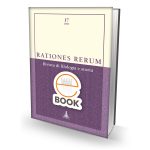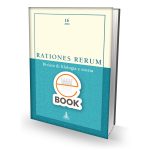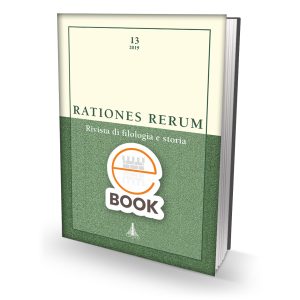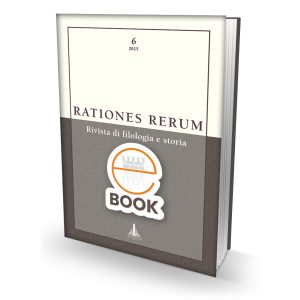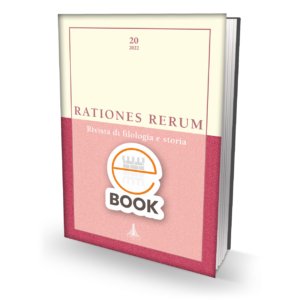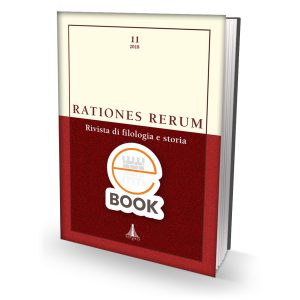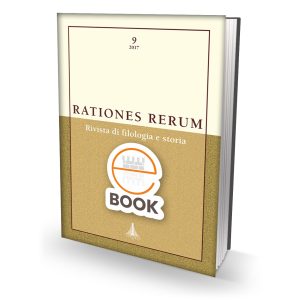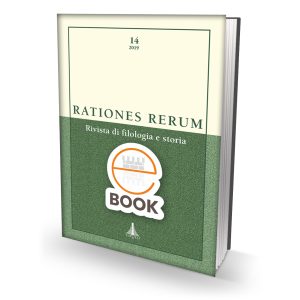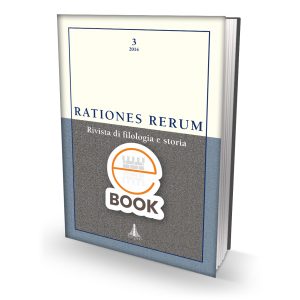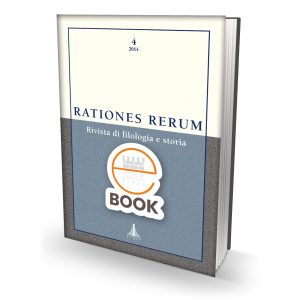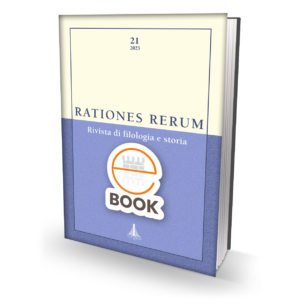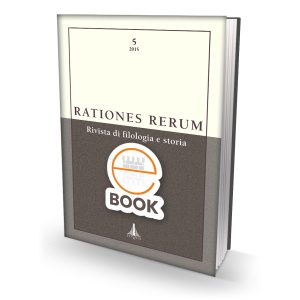RATIONES RERUM 17 – Rivista di filologia e storia (E-book)
35,00 €
Autori vari
Anno edizione: 2021
Formato 17×24 – Pagine 320
ISBN 9788899846619 – ISSN 2284-2497
Prezzo: € 35,00
- Descrizione
- ANTEPRIMA
- ABSTRACTS
Descrizione
Sommario
SECONDO SEMINARIO DI GEOGRAFIA STORICA DEL MONDO ANTICO
L’immagine del mondo nei racconti di viaggio: dalla tradizione storico-letteraria antica al materiale di archivio di età moderna
Serena Bianchetti e Veronica Bucciantini, Presentazione, p. 11
Francesco Prontera, Viaggi e mappae mundi alla scuola di Aristotele, p. 13
Francisco Javier Gómez Espelosín, Heródoto y los relatos de viaje, p. 27
Veronica Bucciantini, William Vincent, The Commerce and Navigation of the Ancients in the Indian Ocean, part II: The Periplus of the Erythraean Sea, London 1807. Note d’autore, p. 41
Michael Rathmann, Nuove ricerche sulla Tabula Peutingeriana, p. 57
Alexandr V. Podossinov, Geographische Reisebeschreibungen in den antiken Romanen, p. 73
Irene Pajón Leyra, Un frammento di prosa del IV secolo a.C. sugli Autariati. Etnografia, storiografia e movimenti di popolazione in P.Oxy. IV 681, p. 85
Francisco J. González Ponce, Esteban de Bizancio, lector de periplos, p. 99
Encarnación Castro-Páez, César y el corpus cesariano. Un episodio en la construcción geográfica de Hispania, p. 117
Serena Bianchetti, I viaggi di Aristea di Proconneso, p. 125
Ekaterina Ilyushechkina, Reading Solinus’ Collectanea rerum memorabilium with Plinianae exercitationes in C. Iulium Solinum by Claudius Salmasius, p. 143
Pietro Janni, «Scandinavi brava gente»: il Viaggio settentrionale di Francesco Negri (1663-1666), p. 157
Francisco Javier González Mora, Plinio y su posible manejo del periplógrafo Andróstenes de Tasos, p. 171
Francisco Jesús Martínez Hidalgo, El Periplo de la Propóntide de Andretas de Ténedos y la tradición geográfica del Bósforo, p. 179
Valerio Capponi Brunetti, Aspetti della rappresentazione della costa iranica nell’opera di Onesicrito di Astipalea, p. 185
Fátima Aguayo Hidalgo, Datos geográficos en Flavio Josefo, p. 191
Rosanna Valentina Femia, Per uno studio di due portolani inediti. Influenze e analogie tra la scuola di Vigliarolo e Placido Oliva, p. 199
Rocco Viccione, Fra oriente e occidente. Temistio sulle rotte di Costanzo II nell’anno 357, p. 209
Francesca Grasso, Geografia astronomica e aristotelismo nell’inedita Disputatio phylosophica di Andrea Chiocco, p. 217
Articoli e studi
Mauro Tulli, Fra poetica e filologia: il dibattito sull’Olimpo nel XXIV libro dell’Iliade, p. 229
Ilaria Sforza, «Le meravigliose tombe degli antichi re» (Diod. 1, 46, 6): da Erodoto a Diodoro, per il tramite degli Aigyptiaka di Ecateo di Abdera, p. 247
Francesco Lo Monaco, Ancora su Catullo in “Francia”, p. 273
Recensioni
Virgilio Costa, rec. a Giovanni Marginesu, Il costo del Partenone. Appalti e affari dell’arte greca, Roma, Salerno Editrice, 2020, p. 283
Federico Santangelo, rec. a Pier Giuseppe Michelotto, Da Pietroburgo a New Haven. Sei saggi su M. I. Rostovtzeff, Milano, Bruno Mondadori, 2020, p. 290
Marco Filippi, rec. a Rita Degl’Innocenti Pierini, Pomponio Secondo: profilo di un poeta tragico “minore” (e altri studi su poesia latina in frammenti), Bologna, Pàtron Editore, 2018, p. 299
Libri ricevuti, p. 303
Abstracts, p. 307
Indice analitico (a cura di Carlo Di Giovine), p. 315
Istruzioni per gli autori, p. 319
Francesco Prontera
Viaggi e mappae mundi alla scuola di Aristotele
pp. 13-26
According to Aristotle (Mete. 1, 13, 350a14-b18), mappae mundi (αἰ τῆς γῆς περίοδοι) are based on travelers’ reports. As the context makes clear, this type of geographic information is not based on discoveries made during military expeditions or private travels, but on the analysis of data and concepts accumulated since the Archaic age. In fact, Aristotle’s geography of Central Asia systematizes traditional knowledge, and in the Meteorologica there is no trace of the new information produced by the conquests of Alexander the Great.
Francisco Javier Gómez Espelosín
Heródoto y los relatos de viaje
pp. 27-40
In his description of the inhabited world, Herodotus makes extensive use of information from so-called travelers’ tales. His work – strictly speaking – does not belong to this genre, although he cites his own travels and those of others as the main foundation for the credibility and consistency of his image of the world. In the Histories, however, his personal experience often remains blurred amidst the accumulation of information from other sources that make travel the main basis of their testimony. In contrast to the image of the world sketched by poets or Ionian thinkers, Herodotus claims that journeys constitute the principal basis of his account.
Veronica Bucciantini
William Vincent, The Commerce and Navigation of the Ancients in the Indian Ocean, Part II: The Periplus of the Erythraean Sea, London 1807. Note d’autore
pp. 41-56
William Vincent (1739-1815), Dean of Westminster, had a predilection for classical culture and studied several Greek texts concerning navigation in the ancient world. This article analyzes some of Vincent’s handwritten notes on a copy of the reprint of the first volume of The Periplus of the Erythraean Sea to understand how his scholarly interests and his close ties with the British Crown might have influenced his attention to these texts. Vincent’s brilliant career as the head of the most important place of worship in London suggests a close link with the Royal Court, and it should be emphasized that from 1797 to 1809 he devoted himself to the study of sea routes in the Indian Ocean and their updating in the light of all the news coming from the accounts of English travelers. Motivating this direction of his research were not only Vincent’s love for classical studies, but also the political and commercial interests of King George III, who, through William Pitt the Younger, powerfully favored Vincent’s career.
Michael Rathmann
Nuove ricerche sulla Tabula Peutingeriana
pp. 57-72
In recent studies on the Tabula Peutingeriana, several new questions have been investigated. It has become apparent, for example, that the southern mountain range of Africa is a cartographical metaphor for “much unknown land”. The draftsmen of the original Tabula Peutingeriana probably “invented” this evocative designation for reasons of space, since on the rotulus there was no room for additional land masses. Furthermore, the discontinuous mountain range of the Alps, including the forested depictions of the Vosges and the Black Forest, can be traced back to the map’s origin in the Hellenistic period. Changes in the internal cartographical design of the Tabula Peutingeriana caused by copying techniques are sometimes particularly evident. For instance, the area north of the lower Danube, where the Roman province of Dacia is recorded, probably derives from the map’s Hellenistic archetype, since this area was originally filled with information on the southern Scythian area (well known since the period of Alexander the Great). In addition, some interesting mistakes in the Tabula Peutingeriana can be explained as the result of ancient copying procedures, such as the “shift” of the Roman road along the Raetian limes north of the Danube to the southern bank of the river. In this case, one of the copyists apparently misinterpreted the abandonment of the Raetian limes after 260 AD.
Alexandr V. Podossinov
Geographische Reisebeschreibungen in den antiken Romanen
pp. 73-83
This article investigates Greek geographic knowledge as it is reflected in ancient novels. In most of them, the heroes travel frequently (mainly by sea), escape from enemies, are taken captive by pirates, go in search of relatives and loved ones, travel for commercial purposes, visit different cities and shrines, etc. Most of these works were composed by authors very well educated in geography and for readers who were also privy to this knowledge. Geographical descriptions in novels differed from scientific descriptive geography only in that they were sometimes fictional, and even if they appeared realistic, they were written in a lively way.
Irene Pajón Leyra
Un frammento di prosa del IV secolo a.C. sugli Autariati. Etnografia, storiografia e movimenti di popolazione in P.Oxy. 4 681
pp. 85-97
This article offers a new edition of and commentary on P.Oxy. 4 681. Traditionally interpreted as a historiographical or geographical fragment concerning some Illyrian tribes (the names of the Triballi and Paeonians are clearly readable), this study instead interprets it as a text dealing with another Illyrian ethnic group: the Autariatae, once the most powerful tribe of the Illyrians. New readings and textual reconstructions contribute to identifying this document as a work of Greek historiography written by the year 310 BCE, when the decline of the Autariatae began.
Francisco J. González Ponce
Esteban de Bizancio, lector de periplos
pp. 99-116
The fragments of ancient Greek periplography mostly come from Marcian of Heraclea, Strabo, and the scholiasts on Apollonius of Rhodes. This article, however, considers the case of Stephanus of Byzantium, who is shown to be acquainted with 14 periplographical writings, 4 of them surviving to the present day, the remaining 10 preserved only as fragments. Analysis of the extant works allows us to affirm, with due caution, that Stephanus knew and managed the two “editorial projects” which later were recorded in the medieval codices A(B) (Arrian?) and D (Marcian). As for fragmentary sources, Stephanus seems to have agreed more with the scholiasts on Apollonius than with Marcian of Heraclea. This conclusion allows us to re-examine the relationship between Marcian and Stephanus, which is usually considered to have been contemporaneous.
Encarnacion Castro-Páez
César y el corpus cesariano. Un episodio en la construcción geográfica de Hispania
pp. 117-124
This article aims to study the possible geographical allusions to the Iberian Peninsula in Caesar’s works and in the corpus Caesarianum.
Serena Bianchetti
I viaggi di Aristea di Proconneso
pp. 125-142
The space devoted by Herodotus to Aristeas’ travels provides an updated description of the inhabited world compared to that of Hecataeus. The author of the Histories selects – in particular from Aristeas’ Arimaspea – data to define the region to the north-east of the Caspian Sea: this was considered an open sea by Hecataeus, but a closed sea by Herodotus, who relies on Persian documents and on reports of the merchants who used to meet in Olbia. The Issedonians, considered non-Scythians by Aristeas and Herodotus, were one of the Scythian peoples for Hecataeus, who had a different and less precise image of Scythia. Through the references to the Issedonians, drawn from the work of Aristeas and examined here, we can better understand the map of the world that underlies Herodotus’ historical account.
Ekaterina Ilyushechkina
Reading Solinus’ Collectanea rerum memorabilium with Plinianae exercitationes in C. Iulium Solinum by Claudius Salmasius
pp. 143-156
In the Prolegomena to his enormous commentary on C. Iulius Solinus’ Collectanea rerum memorabilium, Claude de Saumaise (aka Claudius Salmasius, 1588-1653) compares Pliny’s Naturalis Historia with an endless ocean; therefore, he chooses to consult Solinus’ more concise geographical compilation. Today, Saumaise’s commentary itself seems an immense ocean in which one finds an amazing diligence for dealing with the text being studied, together with a deep knowledge of all the historical, philological, and paleographic questions it generates. This article analyses selected passages from this little-known commentary.
Pietro Janni
«Scandinavi brava gente»: il Viaggio settentrionale di Francesco Negri (1663-66)
pp. 157-169
Francesco Negri, an Italian Catholic priest born in Ravenna in 1623, undertook in the years 1663-1666 two quite adventurous journeys in Scandinavia (Sweden, Norway, Lapland) and wrote an account of them published posthumously (Viaggio settentrionale, 1670). Negri, on the one hand, was a gifted observer, with an already modern spirit, and a son of the 17th century; on the other hand, he remained sometimes tied to beliefs with a medieval flavor. His observations on the flora and fauna of the northern countries and on the human world – especially on the Lapps, concerning whom he notes the physical and cultural peculiarities that differentiate them from the “genuine” Scandinavians of Germanic lineage – were precious for his time, divulging knowledge of a world that was still remote as far as the main centers of European culture were concerned. At the same time, he is not completely free of beliefs that were then widespread, especially among Christian missionaries in other parts of the world. For example, he maintains that the Lapps had been apparently converted to Christianity but in secret remained idolaters practicing all sorts of witchcraft and diabolical rites. Nonetheless, he corrects in a truly scientific spirit many absurdities of previous writings on the same topic, especially those of his predecessor Olaus Magnus, the Catholic archbishop of Uppsala and the celebrated author of the Historia de gentibus septentrionalibus.
Francisco Javier González Mora
Plinio y su posible manejo del periplógrafo Andróstenes de Tasos
pp. 171-177
The little we can read today of Sailing along the Indian Coast by Androsthenes of Thasos, trierarch and explorer under Alexander the Great, mainly comes from what has been transmitted by Theophrastus and Eratosthenes. But there is evidence for certain tacit parallels in Pliny, who must have known Androsthenes primarily through Juba. The latter, in turn, would have obtained most of his information from Eratosthenes, although it must also be considered that Juba owes a significant debt to Theophrastus.
Francisco Jesús Martínez Hidalgo
El Periplo de la Propóntide de Andretas de Ténedos y la tradición geográfica del Bósforo
pp. 179-184
The only surviving fragment of Androitas of Tenedos’ Periplus of the Propontis deals with the mythical journey of the Argonauts and the legend of Poseidon’s son Amycus. However, the mention made of Nymphaeus of Chalcedon offers the possibility of putting aside mythical locations to examine the geography of the Bosphorus strait. For this purpose, this article considers a series of interesting pieces of evidence that aid in the philological analysis of the fragment of our author. Consulting works of authors such as Dionysius of Byzantium, Arrian, and Stephanus of Byzantium, the article investigates the geographical tradition about the Bosphorus strait, to offer an interpretation of the position of Androitas of Tenedos in comparison to this tradition.
Valerio Capponi Brunetti
Aspetti della rappresentazione della costa iranica nell’opera di Onesicrito di Astipalea
pp. 185-190
Although having witnessed the Macedonian conquest of Asia and served as one of Alexander’s trusted collaborators, Onesicritus of Astypalaea – one of the first Alexandrographers to recount the king’s life – was condemned by later authors as a tendentious and unreliable historian, especially for his penchant for self-glorification, flattery of Alexander, and an excessive fondness for referring to wonders. This article examines some of the incredible tales preserved in the fragments of Onesicritus concerning the report he wrote on the naval exploration of the Iranian coast (325-324 BC), in which he took part as an officer under the command of Nearchus of Crete. The aim of the analysis is to clarify the significance and purpose of these θαυμάσια in their context, i.e. an historical account focused on the exploration of unknown regions where the borders of Alexander’s empire and those of the known world overlapped.
Fátima Aguayo Hidalgo
Datos geográficos en Flavio Josefo
pp. 191-198
Flavius Josephus was a careful reader of Strabo’s lost Historical Memoirs (Ἱστορικὰ ὑπομνήματα), as is shown by his twelve quotations from them. But did he also pay attention to geography? When comparing the geographical descriptions in Strabo’s Geography and in the Jewish War, it is evident that Josephus was familiar with Strabo’s geographical work and took it as a model. Considering that the Jewish War was Josephus’ first composition, it is logical to think that for the Antiquities of the Jews, which was composed later, he made use of the geographical knowledge that he had obtained from Strabo.
Rosanna Valentina Femia
Per uno studio di due portolani inediti: influenze e analogie tra la scuola di Vigliarolo e Placido Oliva
pp. 199-208
This article compares an unpublished pilot book found in 2015 in the National State Archives of Catanzaro with another pilot book, also unpublished, conserved in the National State Archives of Florence and attributed to Placido Oliva. The comparison includes the cartographic production of Domenico Vigliarolo, the anonymous Borgiano VI, a pilot book in the Vatican Apostolic Library cataloged as coming from the library of Pope Alessandro VI Borgia, and a pilot book in the Library of Congress, Washington, DC. The “parchment of Catanzaro” is attributed to a local school, active between 1565 and 1615 and indebted to Domenico Vigliarolo and Placido Oliva.
Rocco Viccione
Fra Oriente e Occidente. Temistio sulle rotte di Costanzo II nell’anno 357
pp. 209-216
This article focuses on the mobility of emperors in the late Roman Empire and the journeys that city ambassadors had to undertake on missions to rulers during their travels. In 357, for example, the philosopher Themistius composed two embassy speeches on behalf of Constantinople for the emperor, who was in Italy. Speech III was delivered personally by the philosopher in Rome during the visit of Constantius II, while Speech IV was declaimed in Constantinople because Themistius decided not to travel, citing the difficulties of a winter journey as a pretext.
Francesca Grasso
Geografia astronomica e aristotelismo nell’inedita Disputatio phylosophica di Andrea Chiocco
pp. 217-225
The Supernova of 1604, the so-called “nova stella”, first observed in October by an Italian scholar, caused a heated debate on its genesis especially between mathematicians and Aristotelian philosophers. The up-to-now unpublished Disputatio phylosophica of Andrea Chiocco, philosopher and physician, shows how the Peripatetic School in Padua (whose most important leader at the time was Cesare Cremonini) tried to oppose the mathematical theories of Galileo Galilei. Galileo, soon after the first observation of the Supernova, gave three public lectures in Padua, in order to explain this natural phenomenon and prove that the principle of the immutability of the First Heaven – on which Aristotle’s physical system was based – was wrong.
Mauro Tulli
Fra poetica e filologia: il dibattito sull’Olimpo nel XXIV libro dell’Iliade
pp. 229-245
Homer, in the last book of the Iliad, portrays the fury of Achilles in treating Hector’s dead body, which is protected from destruction by Apollo but nevertheless dragged by Achilles in the dust round and round Patroclus’ tomb in a drawn-out episode that seems endless. To find a solution, Homer draws our attention to Olympus. In the council of the Gods that ensues, an intense and harsh dialogue between Apollo, Hera, and Zeus takes place. The final decision is to instigate an extremely dangerous meeting between Achilles and Priam, with the goals of ending Achilles’ fury and returning Hector’s body. Many traits emerge in this section of the text that anticipate the Odyssey and, ever since antiquity, have attracted philological attention. In any case, it is possible to conceive of the council of the Gods as an important contribution to subsequent Greek poetics: what Apollo proposes to Zeus is to transform Achilles into the new hero of the Odyssey – mores flexible, more human, not locked into an unalterable state of mind. In this way, the previous perspective of the Iliad comes to an end, as Hera in fact hints by referring to the role played by Apollo in the wedding of Peleus and Thetis, and Homer opens the way to the great plot of the Odyssey.
Ilaria Sforza
«Le meravigliose tombe degli antichi re» (Diod. 1, 46, 6): da Erodoto a Diodoro, per il tramite degli Aigyptiaka di Ecateo di Abdera
pp. 247-272
This article reconsiders the relationship between the first book of Diodorus’ Historical Library and its sources, with a special focus on Hecataeus’ Aigyptiaka as an intermediate source with respect to Herodotus’ Book II. After an overview of 19th century criticism on Diodorus and also recent reappraisal, a critical discussion is presented concerning the sole quotation of Hecataeus in the Library (1, 46, 6-8), with the aim of clarifying Diodorus’ historiographical method.
Francesco Lo Monaco
Ancora su Catullo in “Francia”
pp. 273-281
This article examines new evidence on a variant to the text of Priscianus’ Ars 7, 22 (in which Catullus 37, 18 is mentioned) transmitted by three 9th century manuscripts (Par. lat. 7502, Vat. lat. 1480 and Reims 1094) and added to the 11th century manuscript Coloniensis 202. The article also investigates a possible presence of Catullus’ text in the Lower Rhine area during the Middle Ages.


